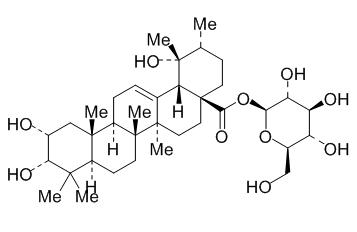Kajiichigoside F1
Kajiichigoside F1 shows haemolytic and in vitro antiviral activity; it also exhibits in vivo hepatoprotective effects, it can inhibit d-GalN-induced cytotoxicity in primary cultured mouse hepatocytes(IC50=14.1uM). Kajiichigoside F1 shows antiinflammatory/antinociceptive action in acetic acid-induced writhing and hot plate testing and in a carrageenan-induced paw edema model in mice and rats.
Inquire / Order:
manager@chemfaces.com
Technical Inquiries:
service@chemfaces.com
Tel:
+86-27-84237783
Fax:
+86-27-84254680
Address:
1 Building, No. 83, CheCheng Rd., Wuhan Economic and Technological Development Zone, Wuhan, Hubei 430056, PRC
Providing storage is as stated on the product vial and the vial is kept tightly sealed, the product can be stored for up to
24 months(2-8C).
Wherever possible, you should prepare and use solutions on the same day. However, if you need to make up stock solutions in advance, we recommend that you store the solution as aliquots in tightly sealed vials at -20C. Generally, these will be useable for up to two weeks. Before use, and prior to opening the vial we recommend that you allow your product to equilibrate to room temperature for at least 1 hour.
Need more advice on solubility, usage and handling? Please email to: service@chemfaces.com
The packaging of the product may have turned upside down during transportation, resulting in the natural compounds adhering to the neck or cap of the vial. take the vial out of its packaging and gently shake to let the compounds fall to the bottom of the vial. for liquid products, centrifuge at 200-500 RPM to gather the liquid at the bottom of the vial. try to avoid loss or contamination during handling.
J Pharm Biomed Anal.2023, 234:115570.
Environ Toxicol.2019, 34(12):1354-1362
bioRxiv-Pharm.&Toxi.2022, 2022.481203.
bioRxiv2021, 462065.
Appl. Sci.2025, 15(1), 247
Fermentation2023, 9(10), 889
FUTURE VIROLOGYVOL.2023, 18(5).
J Pharmaceut Biomed2020, 182:113110
Molecules.2018, 23(10):E2638
Chin J Pharm Anal.2019, 39(7):1217-1228
Related and Featured Products
Biol Pharm Bull. 2005 Jan;28(1):101-4.
19Alpha-hydroxyursane-type triterpenoids: antinociceptive anti-inflammatory principles of the roots of Rosa rugosa.[Pubmed:
15635171]
To search for antiinflammtory 19alpha-hydroxyursane-type triterpenoids, the MeOH extract of the roots of Rosa rugosa (Rosaceae) was fractionated.
METHODS AND RESULTS:
The active fraction of the EtOAc extract was hydrolyzed in alkaline solution to give a hydrolyzed fraction. Both extracts showed antiinflammatory/antinociceptive action in acetic acid-induced writhing and hot plate testing and in a carrageenan-induced paw edema model in mice and rats. Repeated chromatography of the EtOAc extract on both silica gel and octadecylsilane columns led to the isolation of Kajiichigoside F1 (1, euscaphic acid 28-O-glucoside) and rosamultin (2, tormentic acid 28-O-glucoside). The hydrolyzed fraction was also subjected to silica gel column and octadecylsilane column chromatography to produce euscaphic acid (3) and tormentic acid (4). The potencies were observed in the following order: 4>3>2>1.
CONCLUSIONS:
These results suggest that 19alpha-hydroxyursane-type triterpenoids are responsible for the antiinflammatory/antinociceptive action of R. rugosa roots.
Phytochemistry. 2014 Jun;102:169-81.
Hepatoprotective triterpenes from traditional Tibetan medicine Potentilla anserina.[Pubmed:
24697904]
A methanol extract from the tuberous roots of Potentilla anserina (Rosaceae) exhibited hepatoprotective effects against d-galactosamine (d-GalN)/lipopolysaccharide-induced liver injuries in mice.
METHODS AND RESULTS:
Six triterpene 28-O-monoglucopyranosyl esters, potentillanosides A-F, were isolated from the extract along with 32 known compounds, including 15 triterpenes. The structures of potentillanosides A-F were determined on the basis of spectroscopic properties and chemical evidence.
Four ursane-type triterpene 28-O-monoglycosyl esters, potentillanoside A (IC50=46.7μM), 28-O-β-d-glucopyranosyl pomolic acid (IC50=9.5μM), rosamutin (IC50=35.5μM), and Kajiichigoside F1 (IC50=14.1μM), inhibited d-GalN-induced cytotoxicity in primary cultured mouse hepatocytes.
CONCLUSIONS:
Among these four triterpenes, potentillanoside A, rosamutin, and kaji-ichigoside F1 exhibited in vivo hepatoprotective effects at doses of 50-100mg/kg, p.o. The mode of action was ascribable to the reduction in cytotoxicity caused by d-GalN.
Planta Med. 1991 Oct;57(5):468-70.
Triterpene saponins from the Chinese drug [Pubmed:
1798803 ]
METHODS AND RESULTS:
From the chinese drug "Daxueteng" (Caulis Sargentodoxae: Sargentodoxa cuneata (Oliv.) Rehd. et Wils.; syn. Holboellia cuneata Oliv.) (Sargentodoxaceae), catechin and two known triterpene saponins, rosamultin (7) and Kajiichigoside F1 (8) have been isolated.
CONCLUSIONS:
Some hitherto unknown reaction products of the saponins are described. Both 7 and 8 show haemolytic and in vitro antiviral activity.



